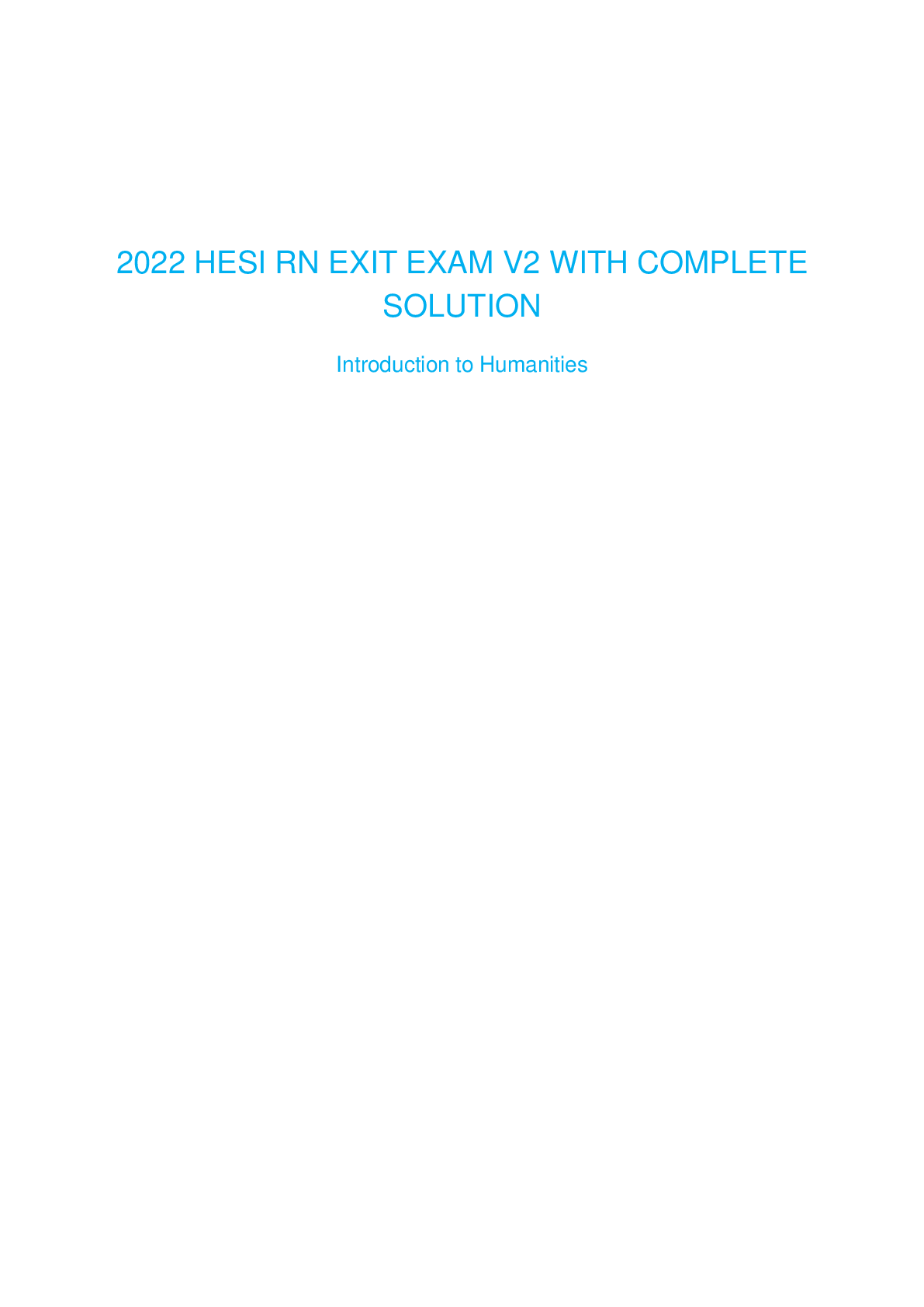ATI RN Mental Health Online Practice B - 60 Questions and Answers
Document Content and Description Below
ATI RN Mental Health Online Practice B ATI RN Mental Health Online Practice 2016 B (60 Questions) 1. A nurse is caring for a client whose child has a terminal illness. The client requests inform... ation about how to deal with the upcoming loss. Which of the following statements should the nurse make: a. "It will be better for you to keep busy to avoid thinking about your child's death." Encouraging the client to avoid thinking about the child's death will not allow the client to begin anticipatory grieving. b. "You will complete the grieving process about a year after your child's death." The grief process has no timeline. It varies for each individual. c. "The grief process will start once your child actually dies." The client can begin anticipatory grieving during the child's illness. d. "It is not uncommon to feel angry toward yourself or others." Feelings of blame and anger towards oneself or others are an expected reaction when a client is experiencing a loss. 2. A nurse is teaching a client who has bipolar disorder and a prescription for lithium. Which of the following instructions should the nurse include in the teaching? a. "Take this medication with food." Lithium can cause gastrointestinal distress. Therefore, this medication should be taken with food. b. c. d. "Reduce sodium intake to 1,000 milligrams each day." The client should maintain an adequate and consistent sodium intake to decrease the risk for lithium toxicity. The recommended sodium intake for adults is 1,500 mg/day. "Limit fluid intake to 1,200 milliliters each day." The client should consume 2,000 to 3,000 mL/day of fluids during initial treatment with lithium. "Be aware that this medication can be addictive." Lithium is not classified as an addictive medication. 3. A nurse is planning care for four clients in a mental health facility. Which of the following clients is at the greatest risk for injury when performing ADLs a. A client who has severe Alzheimer's disease The greatest risk to this client is injury from performing ADLs. Clients who have severe Alzheimer's disease are typically confused, have memory difficulties, tend to wander, and need assistance to perform ADLs. A client who is in the maintenance phase of schizophrenia Clients who are in the maintenance phase of schizophrenia are calm and able to provide self-care with minimal risk for injury. Therefore, another client is at a greater risk for injury. A client who has obsessive-compulsive disorder A client who has obsessive-compulsive disorder typically performs ADLs repetitively and precisely. The client should be able to provide self-care with minimal risk for injury. Therefore, another client is at a greater risk for injury. A client who has dysthymic disorder Clients who have dysthymic disorder may have low energy or chronic fatigue, but they should be able to provide self-care with minimal risk for injury. Therefore, another client is at a greater risk for injury. b. c. d. 4. A nurse who works with newborns is assessing the potential for abuse or neglect. Which of the following family groups should the nurse identify as the highest potential for future child abuse a. A family in which both parents are adolescents A family in which both parents are adolescents indicates a risk for the parents to become abusive toward the newborn due to lack of experience and knowledge regarding parenting. However, another family group is at a higher risk for potential abuse. b. A family in which the parents respond indifferently toward their newborn A family in which the parents act indifferently about their newborn indicates a risk for the parents to become abusive toward the newborn due to impaired bonding. However, another family group is at a higher risk for potential abuse. c. A family where one or both parents witnessed intimate partner violence in the home as children Parents who witnessed intimate partner violence as children are more likely to become abusive themselves. Therefore, this is the family group with the greatest potential for future child abuse. d. A family in which one or both parents has a developmental disability A family in which one or both parents have a developmental disability indicates a risk for the parents to become abusive toward the newborn due to difficulty learning new skills. However, another family group is at a higher risk for potential abuse. 5. A nurse is performing an admission assessment on a client and notices that the client appears withdrawn and fearful. To establish a trusting nurse-client relationship, which of the following actions should the nurse take first a. Inform the client that her admission is confidential. According to evidence-based practice, the nurse should first inform the client about confidentiality during the orientation phase of the nurse-client relationship. b. c. d. Introduce the client to other clients in the day room. The nurse should introduce the client to other clients in the day room to help the client interact with others during the working phase of the nurse-client relationship. However, evidence-based practice indicates that the nurse should take a different action first. Assist the client in facilitating behavioral change. The nurse should assist the client with behavioral change during the working phase of the nurse-client relationship. However, evidence-based practice indicates that the nurse should take a different action first. Determine coping strategies that the client has used in the past. The nurse should determine what coping strategies the client used in the past during the working phase of the nurse-client relationship. However, evidence-based practice indicates that the nurse should take a different action first. 6. A nurse is admitting a client who has schizophrenia to an acute care setting. When the nurse questions the client regarding his admission, the client states, "I'm red, in the head, and I'm going to bed!" The nurse should document the client's speech pattern as which of the following a. Clang association The nurse should document that the client's speech uses clang associations, which often rhyme or contain a string of words that can have the same beginning sound. b. c. d. Word salad In word salad, words are completely meaningless and disorganized. This client's speech pattern is not word salad. Neologism Neologism consists of words that are made up by the client. This client's speech pattern does not contain neologisms. Echolalia In echolalia, the client repeats the words of another person. This client's speech pattern is not echolalia. 7. A nurse is caring for four clients in an inpatient mental health facility. Which of the following clients can give informed consent a. b. c. A 35-year-old client who has major depressive disorder A client who has major depressive disorder is capable of making health care decisions unless the client is determined to be legally incompetent. d. A 17-year-old client who lives with friends Individuals younger than 18 years of age can only provide informed consent if they are married, pregnant, parents, or emancipated. A 50-year-old client who has a blood alcohol level of 0.08 A client who is intoxicated cannot legally give informed consent. A 65-year-old client who just received a dose of morphine A client who has just received morphine, an opioid analgesic, is functionally incompetent due to the medication's effect on the CNS. 8. A nurse in a mental health unit is admitting a client who is anxious because he often hears voices telling him what to do. Which of the following actions should the nurse take a. b. c. d. Ask the client what the voices are saying. It is important for the nurse to ask the client directly about the hallucinations to determine if the client or others are at risk for injury. Tell the client that the voices do not really exist. The nurse should avoid negating the client's hallucination. Touch the client to help reduce his anxiety. Touching the client violates his personal space and may increase, rather than decrease, his anxiety. Instruct the client to go to a quiet room when he hears voices. The nurse should instruct the client to listen to music or use other auditory distractions when he hears voices. 9. A nurse is educating the parent of a child who has a new diagnosis of autism spectrum disorder. Which of the following manifestations of this disorder should the nurse include in the teaching a. b. c. d. Language delay A child who has autism spectrum disorder usually has language delay. Fear of abandonment Fear of abandonment is a manifestation of separation anxiety disorder rather than autism spectrum disorder. Motor and verbal tics Motor and verbal tics are a manifestation of Tourette's syndrome rather than autism spectrum disorder. Hostile behavior Hostile behavior is a manifestation of oppositional defiant disorder rather than autism spectrum disorder. - - - - - - - - - - 57. A nurse in the emergency department is caring for four clients. Which of the following clients is the nurse required to report as a potential victim of abuse a. b.: An older adult client who is bed-bound and has a stage IV pressure ulcer A stage IV pressure ulcer on an older adult client who is bed-bound can indicate physical neglect and warrants mandatory reporting. c. d. A school-age girl who has bruises on her knees Bruises on the knees is an expected finding for a school-age child due to minor injuries and falls during this stage of a life. An adolescent who has a vaginal candida infection Vaginal yeast infections can occur for an adolescent and are not an indicator of abuse. A young adult who is pregnant and has a sprained ankle The physiological change in the center of gravity during pregnancy is a common cause for losing balance, tripping, and spraining an ankle. 58. A nurse is assessing a school-age child who has conduct disorder. Which of the following characteristics should the nurse expect the child to demonstrate a. b. c. d.: Aggression toward animals Aggression toward people and animals is an expected characteristic of a child who has conduct disorder. Feelings of remorse Remorse is not an expected characteristic of a child who has conduct disorder. Extended periods of depression A child who has bipolar disorder is likely to have extended periods of depression. This is not an expected characteristic of a child who has conduct disorder. Deficits in intellectual functioning A child who has intellectual deficit disorder exhibits deficits in intellectual functioning, such as reasoning, abstract thinking, and academic ability. A deficit in intellectual functioning is not an expected characteristic of a child who has conduct disorder. 59. A nurse is preparing to administer diazepam 7.5 mg IV bolus to a client for alcohol withdrawal. Available is diazepam injection 5 mg/mL. How many mL should the nurse administer? (Round the answer to the nearest tenth. Use a leading zero if it applies. Do not use a trailing zero.) Ratio and Proportion STEP 1: What is the unit of measurement the nurse should calculate? mL STEP 2: What is the dose the nurse should administer? Dose to administer = Desired 7.5 mg STEP 3: What is the dose available? Dose available = Have 5 mg STEP 4: Should the nurse convert the units of measurement? No STEP 5: What is the quantity of the dose available? 1 mL STEP 6: Set up an equation and solve for X. Have/Quantity = Desired/X 5 mg/1 mL = 7.5mg/X mL X = 1.5 STEP 7: Round if necessary. STEP 8: Reassess to determine whether the amount to administer makes sense. If there are 5 mg/mL and the prescription reads 7.5 mg, it makes sense to administer 1.5 mL. The nurse should administer diazepam 1.5 mL IV bolus. Desired Over Have STEP 1: What is the unit of measurement the nurse should calculate? mL STEP 2: What is the dose the nurse should administer? Dose to administer = Desired 7.5 mg STEP 3: What is the dose available? Dose available = Have 5 mg STEP 4: Should the nurse convert the units of measurement? No STEP 5: What is the quantity of the dose available? 1 mL STEP 6: Set up an equation and solve for X. Desired x Quantity/Have = X 7.5 mg x 1 mL/5 mg = X mL 1.5 = X STEP 7: Round if necessary. STEP 8: Reassess to determine whether the amount to administer makes sense. If there are 5 mg/mL and the prescription reads 7.5 mg, it makes sense to administer 1.5 mL. The nurse should administer diazepam 1.5 mL IV bolus. Dimensional Analysis STEP 1: What is the unit of measurement the nurse should calculate? mL STEP 2: What is the quantity of the dose available? Quantity 1 mL STEP 3: What is the dose available? Dose available = Have 5 mg STEP 4: What is the dose the nurse should administer? Dose to administer = Desired 7.5 mg STEP 5: Should the nurse convert the units of measurement? No STEP 6: Set up an equation and solve for X. X = Quantity/Have x Conversion (Have)/Conversion (Desired) x Desired/ X mL = 1 mL/5 mg x 7.5 mg/ X = 1.5 STEP 7: Round if necessary. STEP 8: Reassess to determine whether the amount to administer makes sense. If there are 5 mg/mL and the prescription reads 7.5 mg, it makes sense to administer 1.5 mL. The nurse should administer diazepam 1.5 mL IV bolus. 60. A nurse is caring for a client who is taking clozapine. For which of the following findings should the nurse withhold the medication? a. The client reports a sore throat. Clozapine can lead to a potentially fatal blood disorder known as agranulocytosis. Agranulocytosis is a severe drop in a client's WBCs, which leaves the client highly susceptible to infection. The nurse should withhold the medication for any indications of infection and notify the provider. b. The client reports being constipated for 2 days. Constipation is an expected adverse effect of clozapine. Increasing fluid and fiber intake or the administration of stool softeners will decrease the risk for constipation. c. The client reports feeling dizzy when getting out of bed. Orthostatic hypotension is an expected adverse effect of clozapine. Encouraging the client to rise slowly when transitioning from a sitting to a standing position will help to prevent falls and will increase client safety. d. The client has gained 1.4 kg (3 lb) in the past month. Weight gain is an expected adverse effect of clozapine. Following a calorie-controlled diet and participating in regular exercise can help minimize weight gain. [Show More]
Last updated: 5 days ago
Preview 1 out of 53 pages
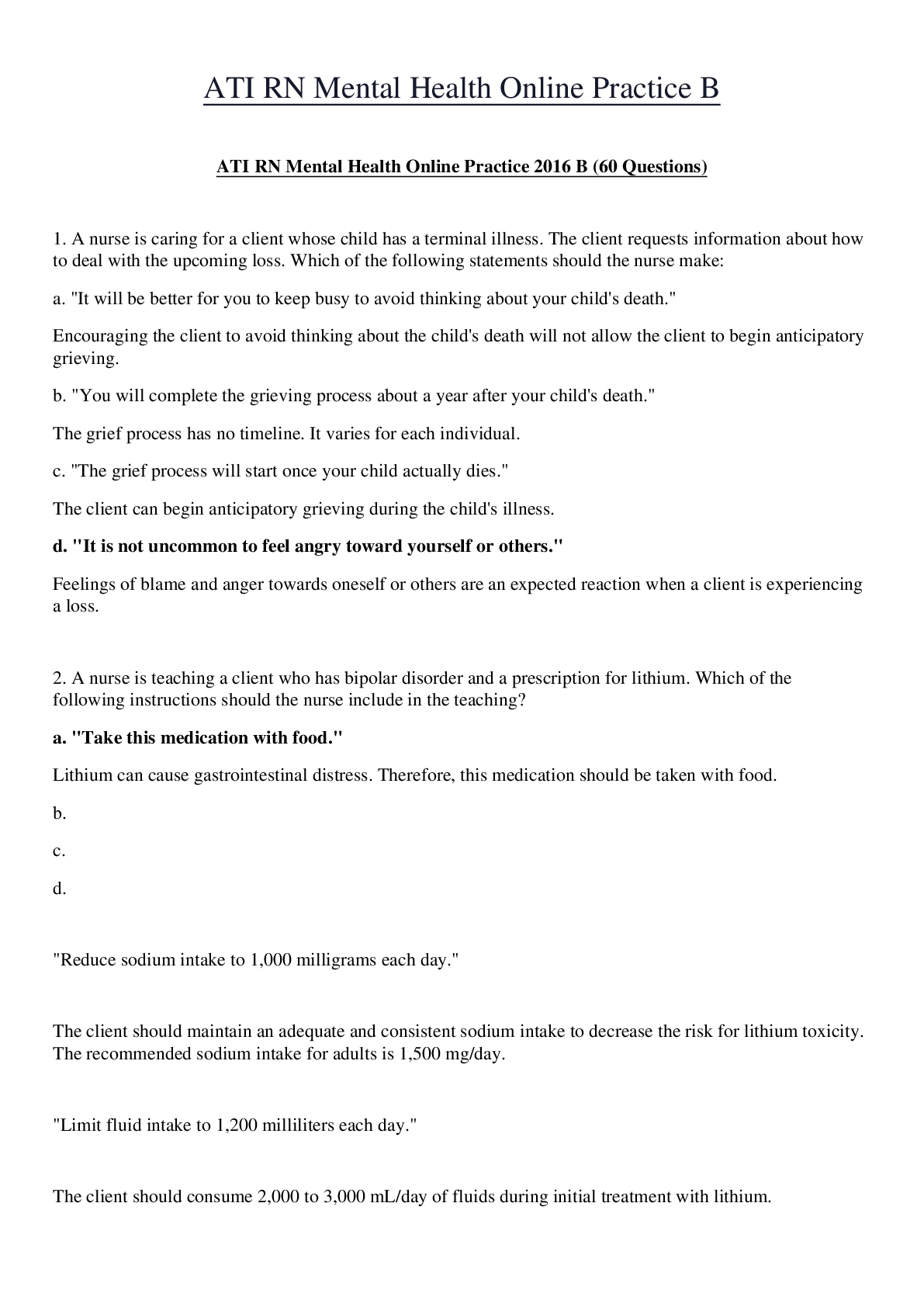
Reviews( 0 )
Document information
Connected school, study & course
About the document
Uploaded On
Jun 07, 2020
Number of pages
53
Written in
Additional information
This document has been written for:
Uploaded
Jun 07, 2020
Downloads
0
Views
68

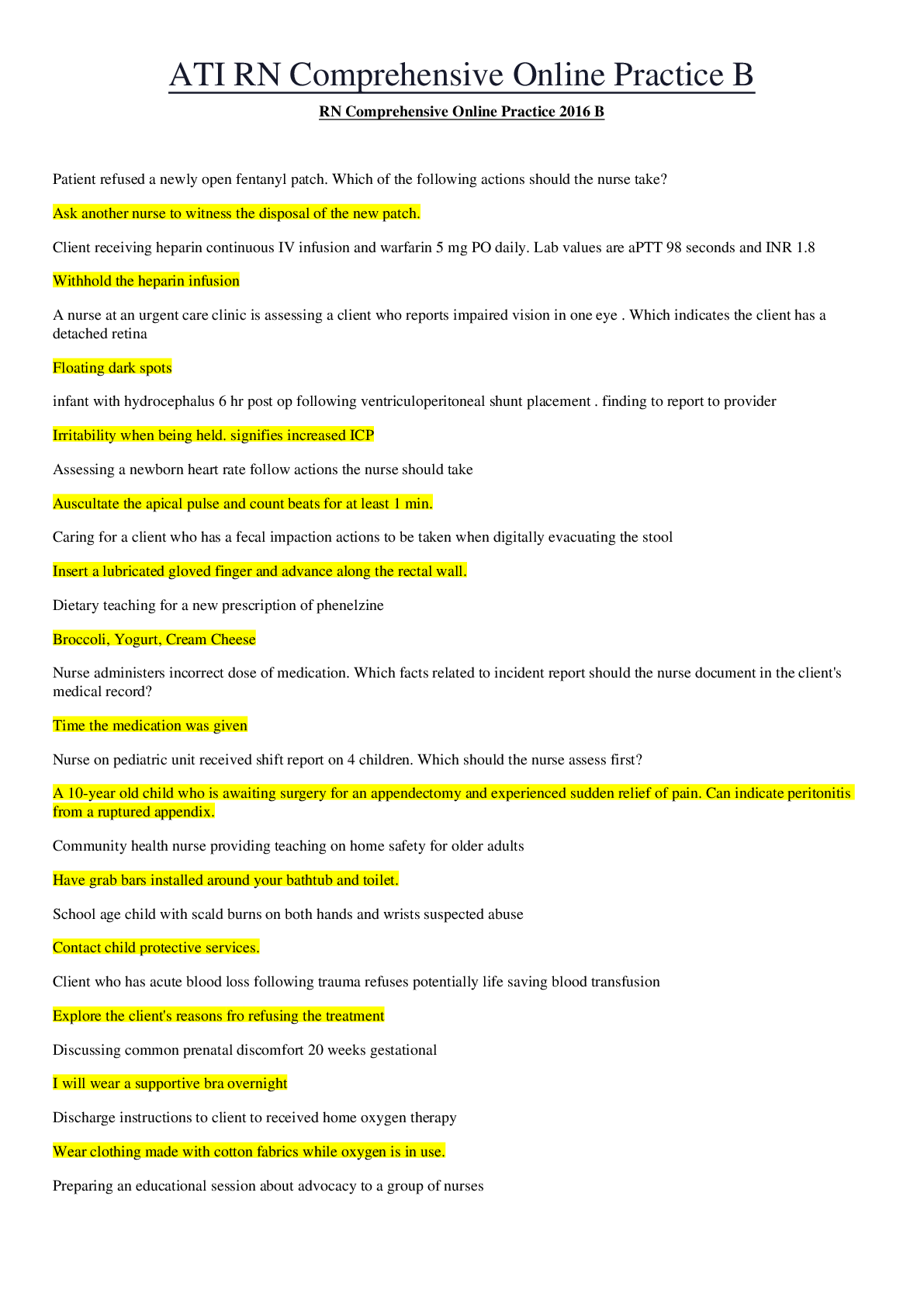
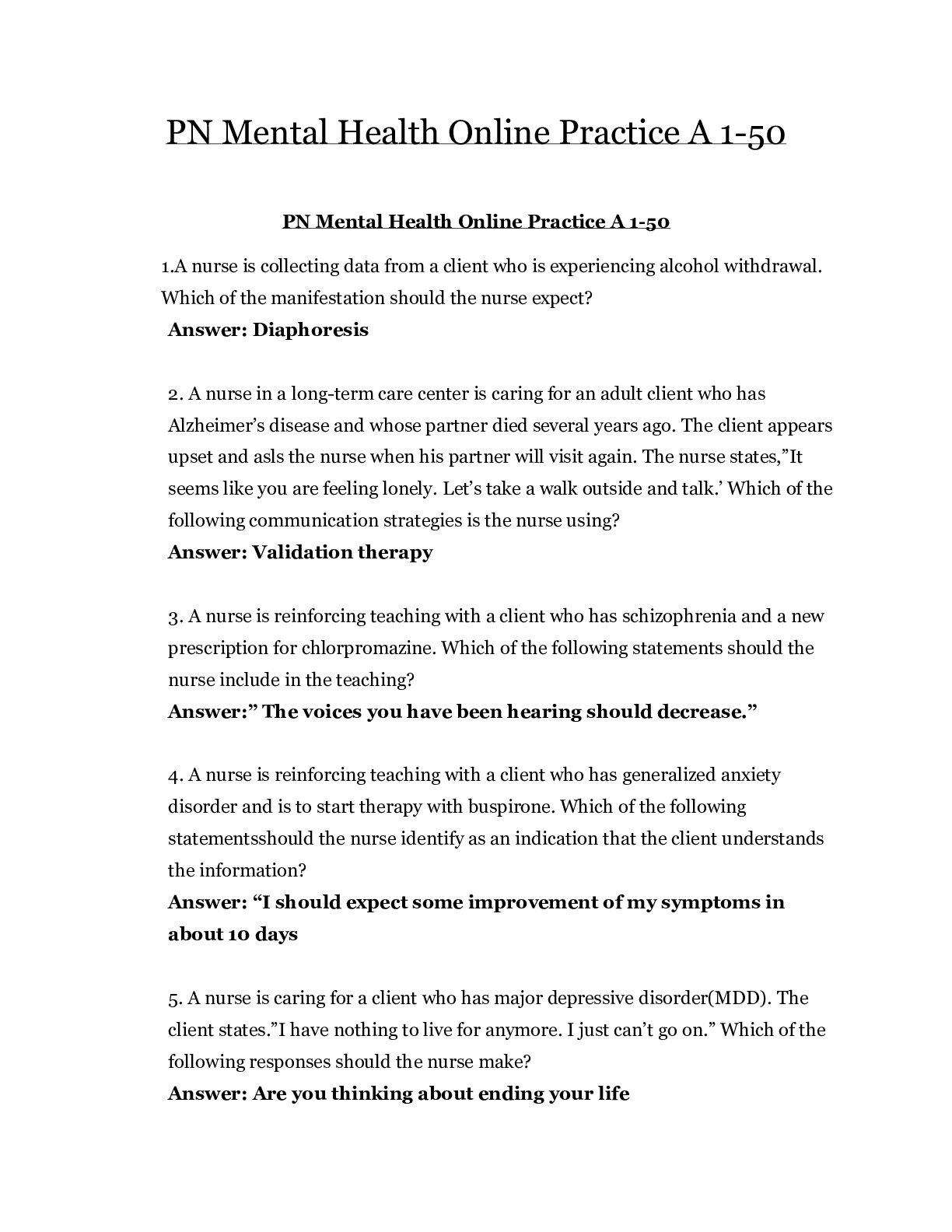
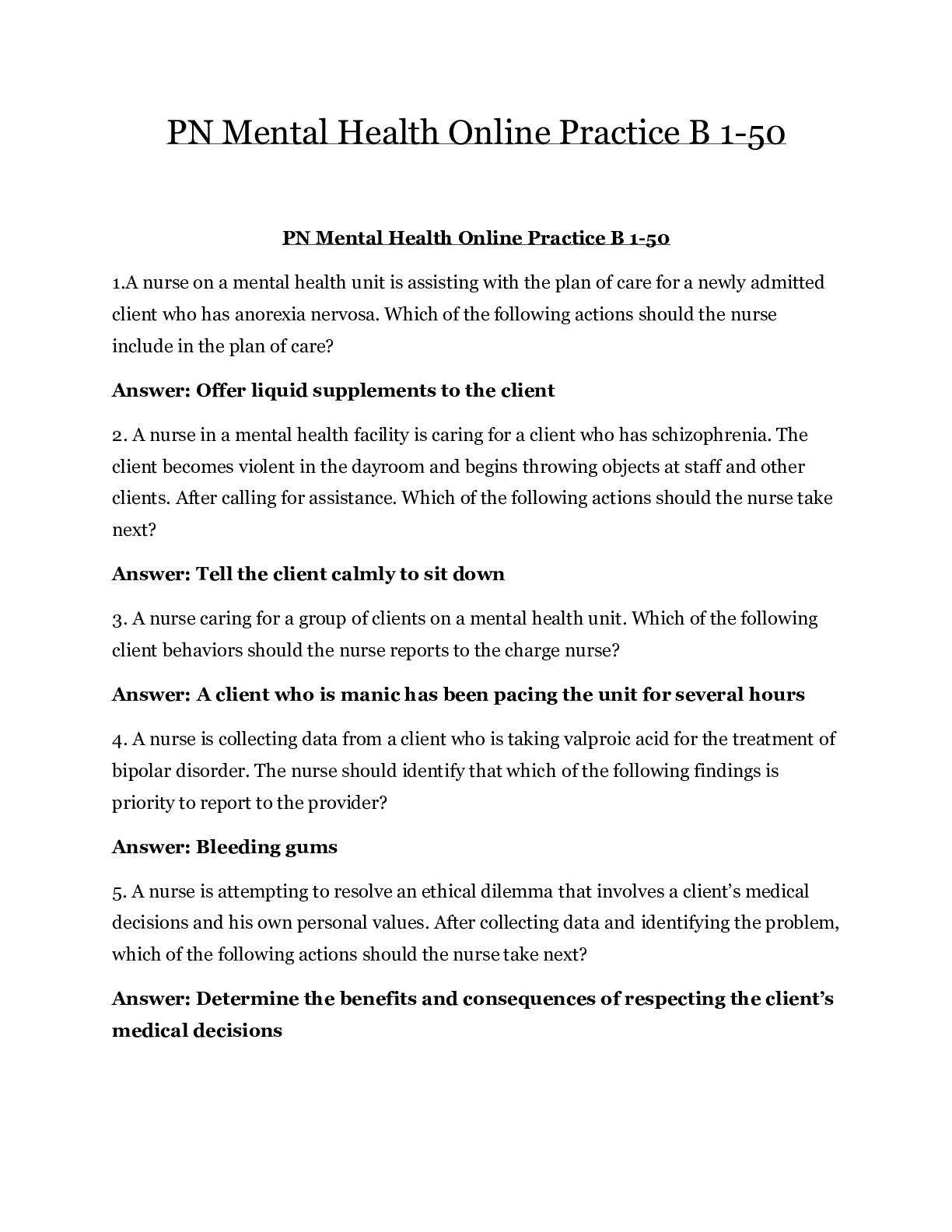


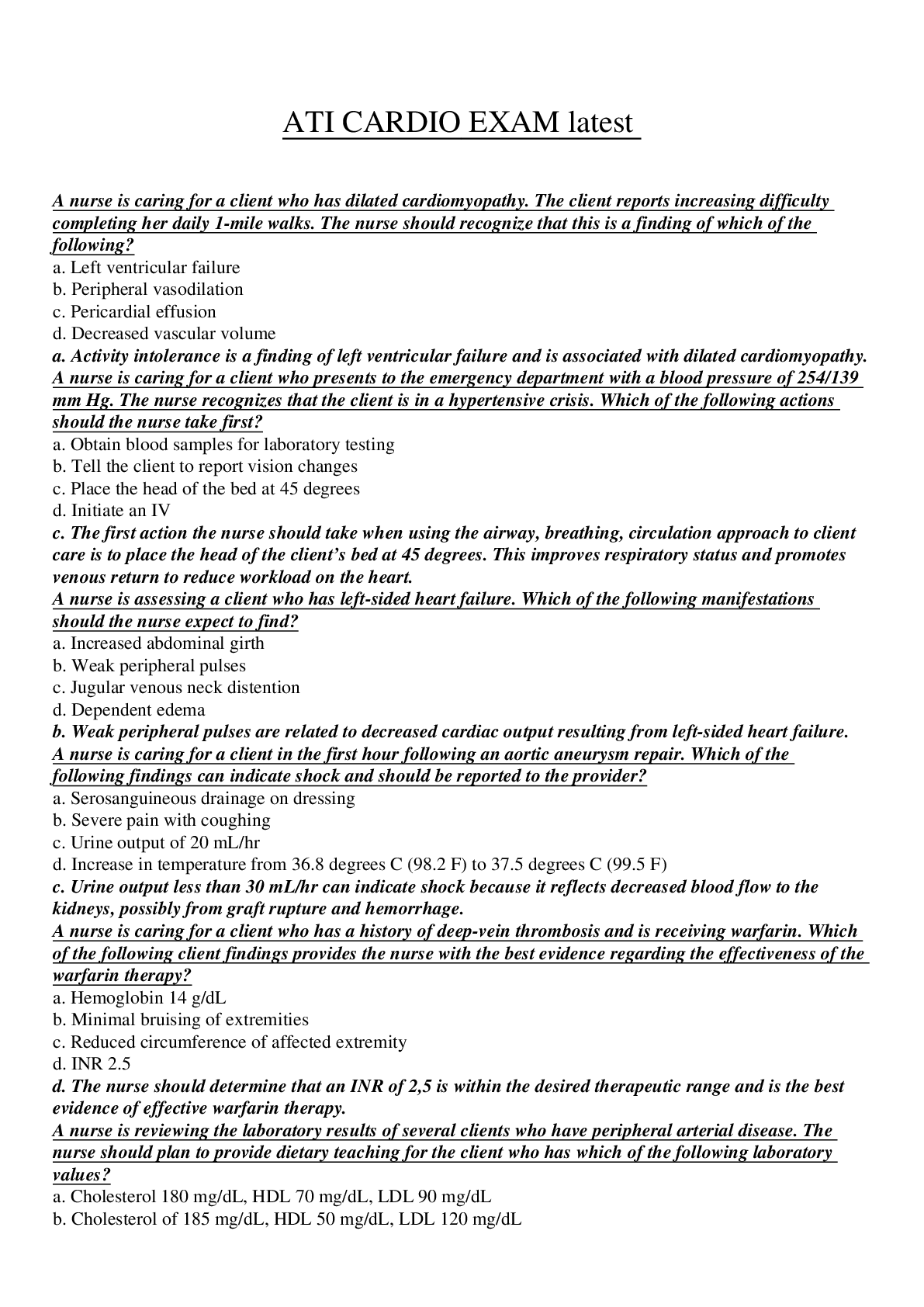
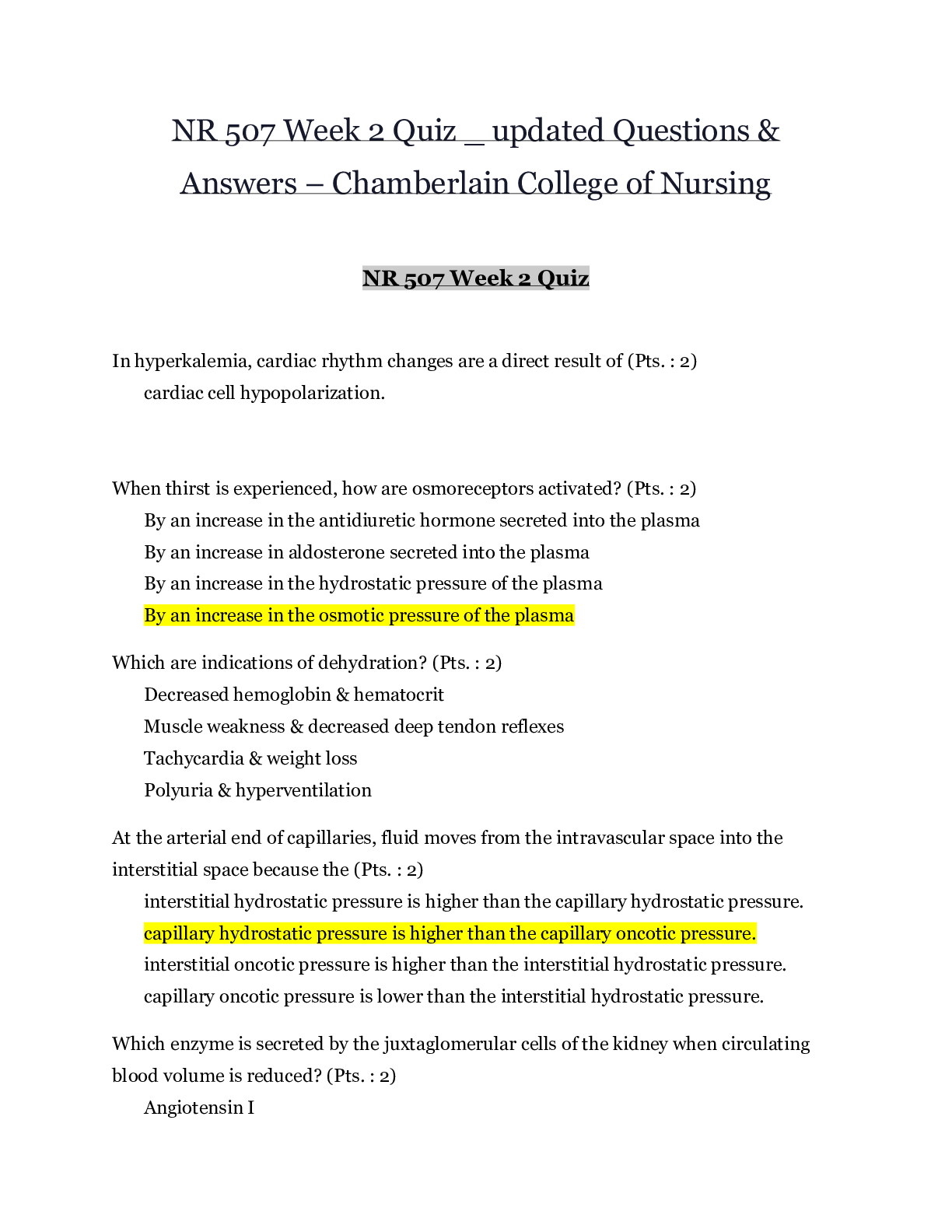
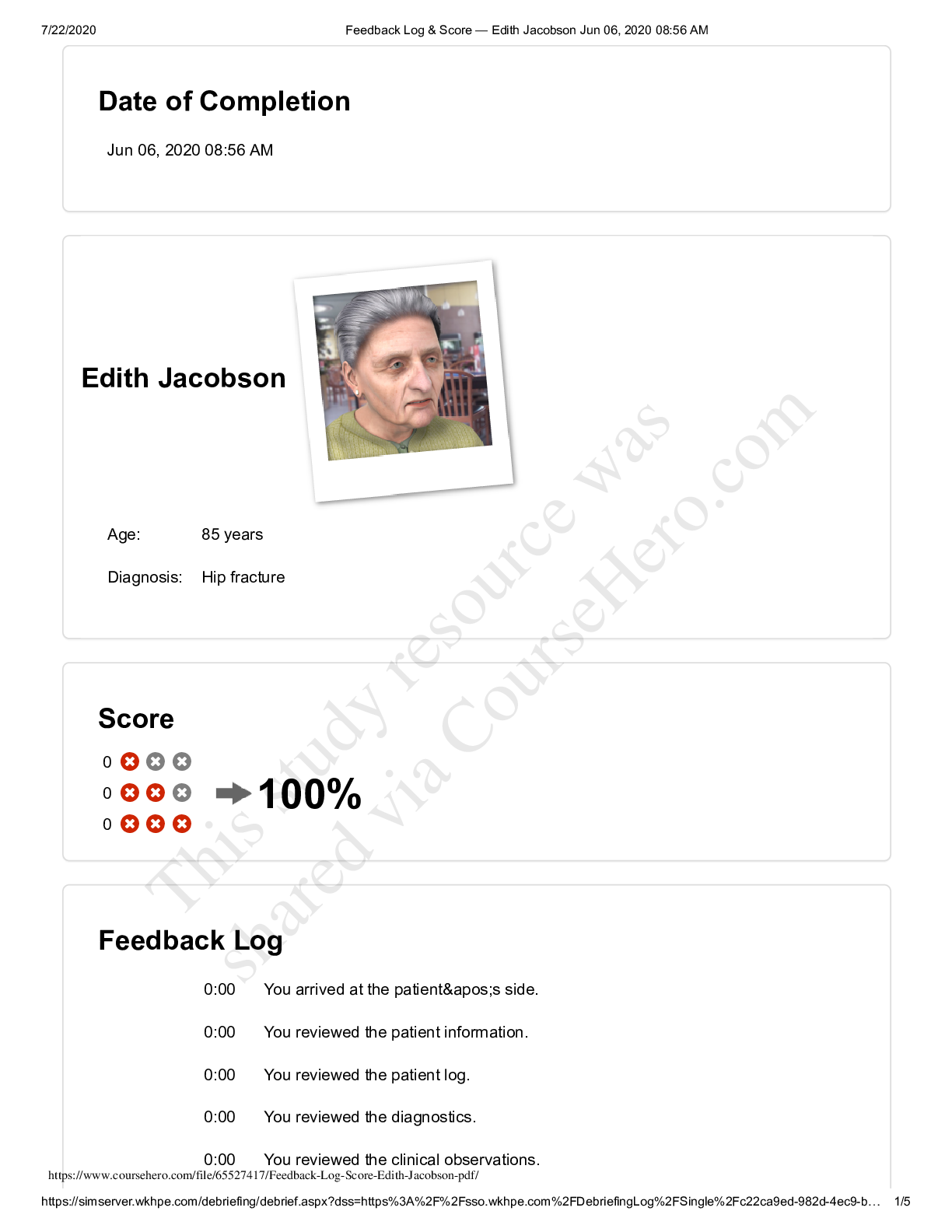
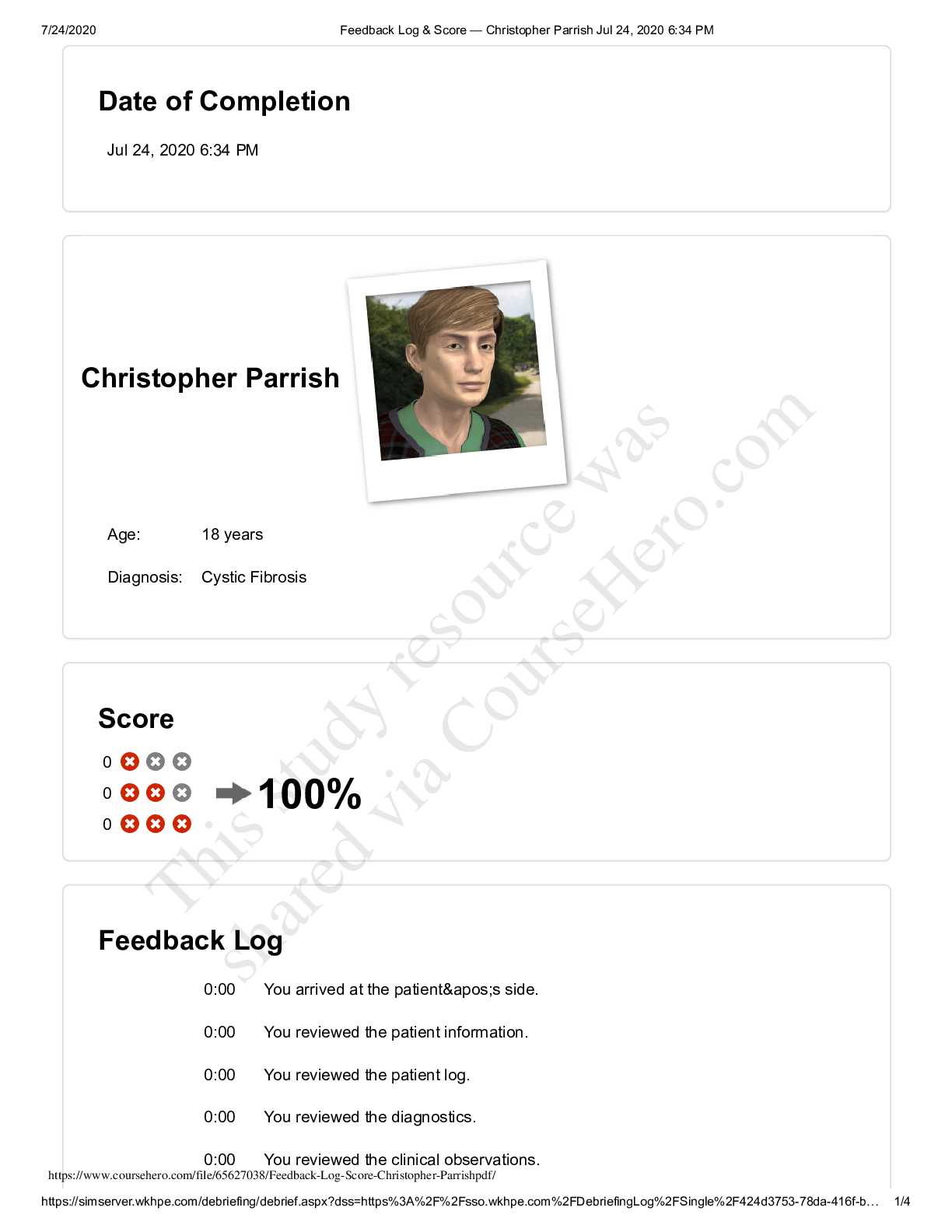
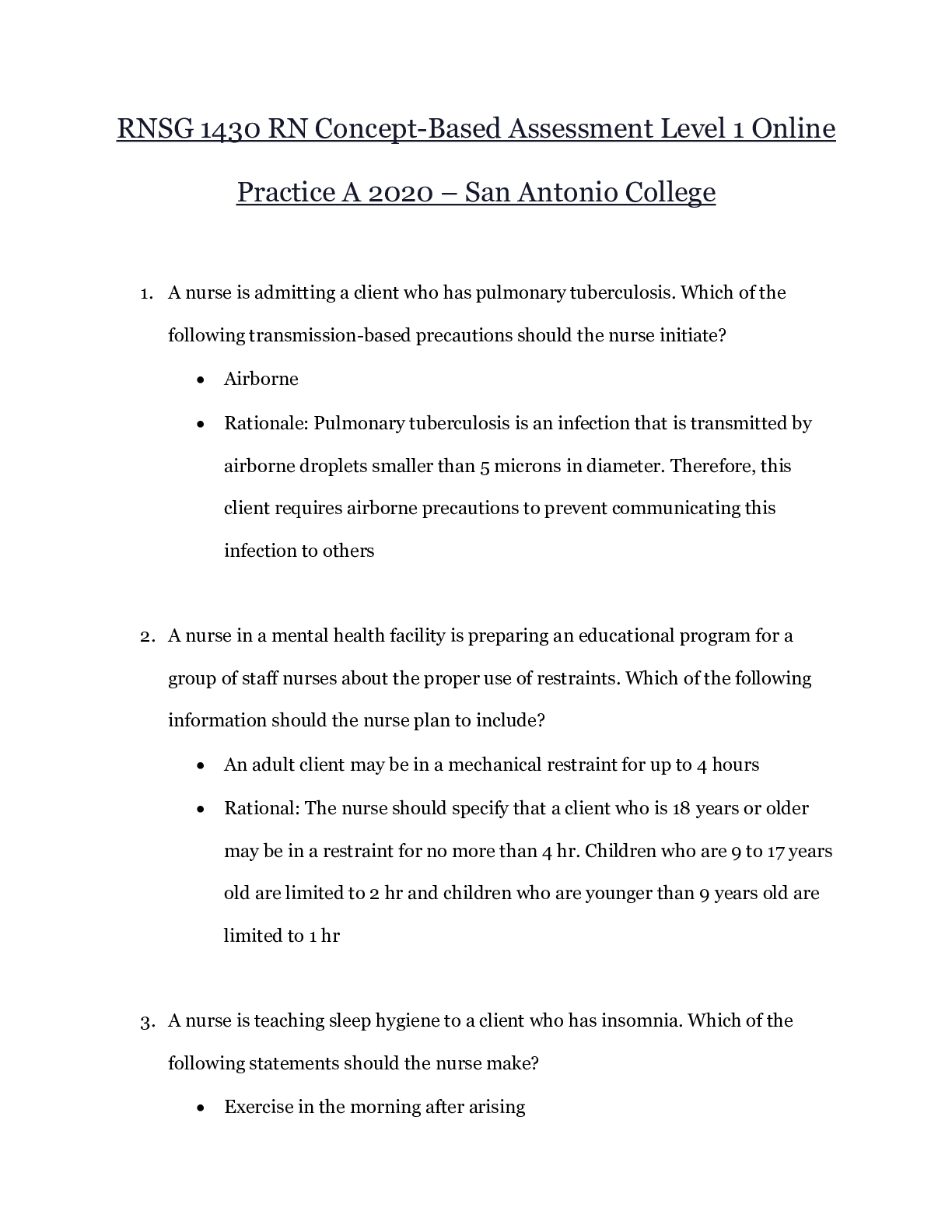


 – CHAMBERLAIN COLLEGE OF NURSING.png)
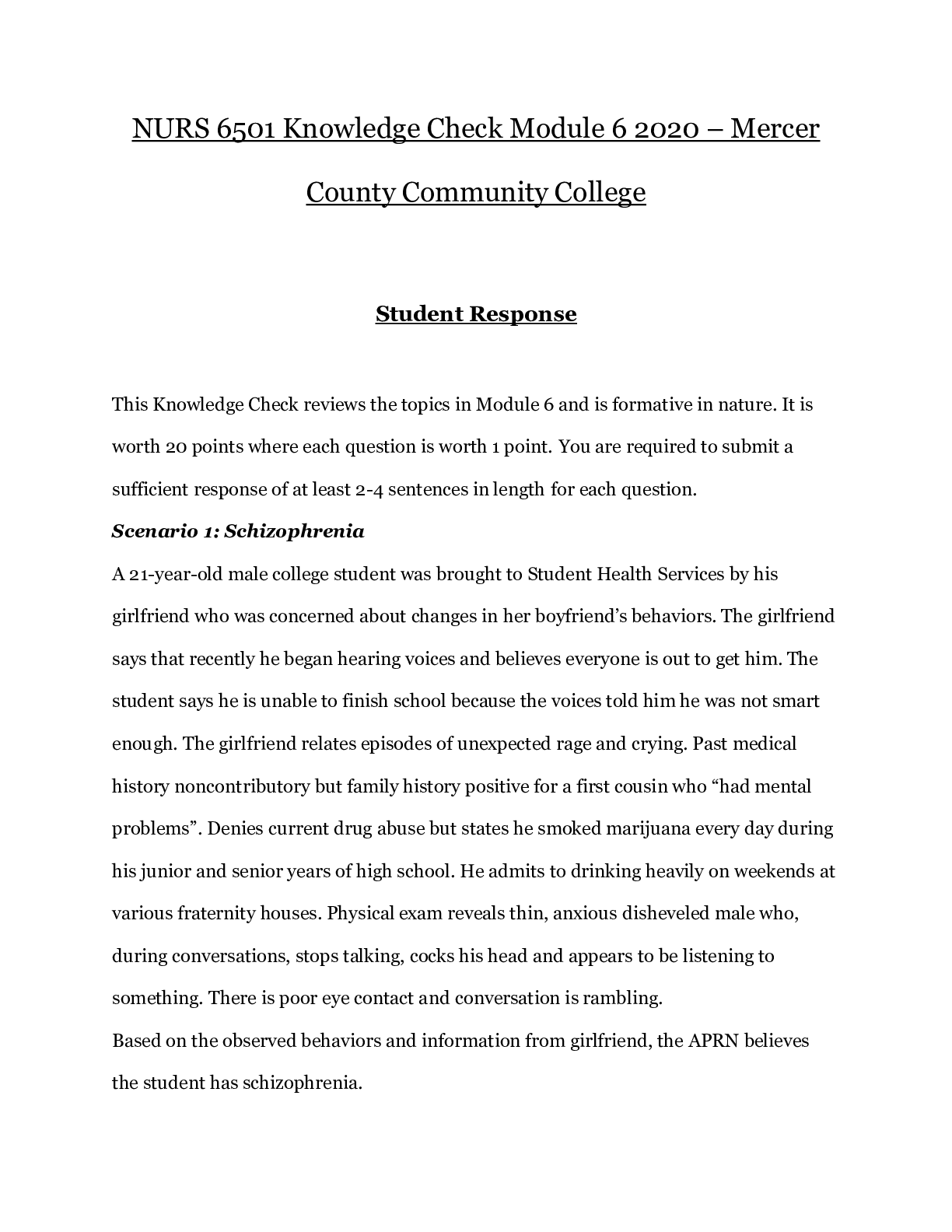
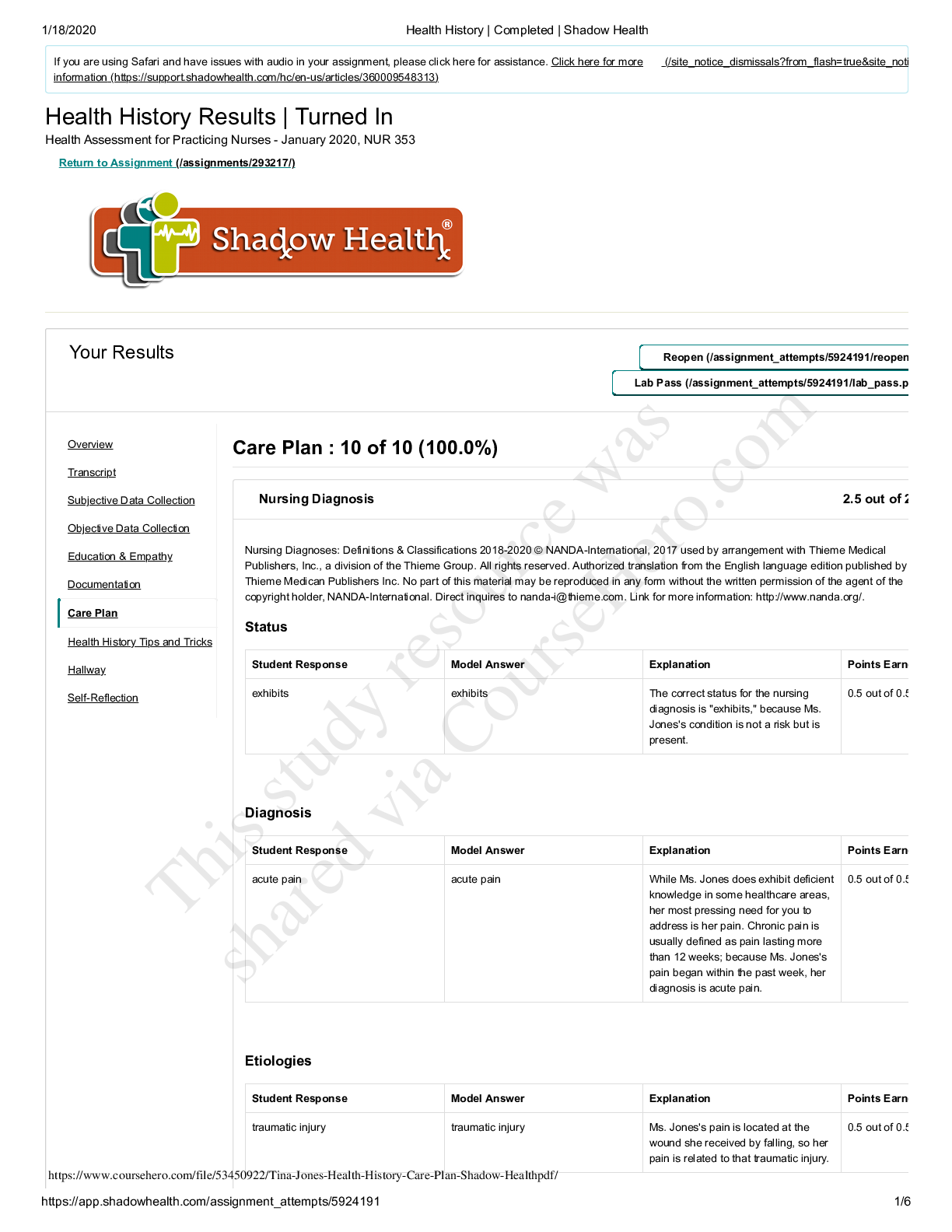
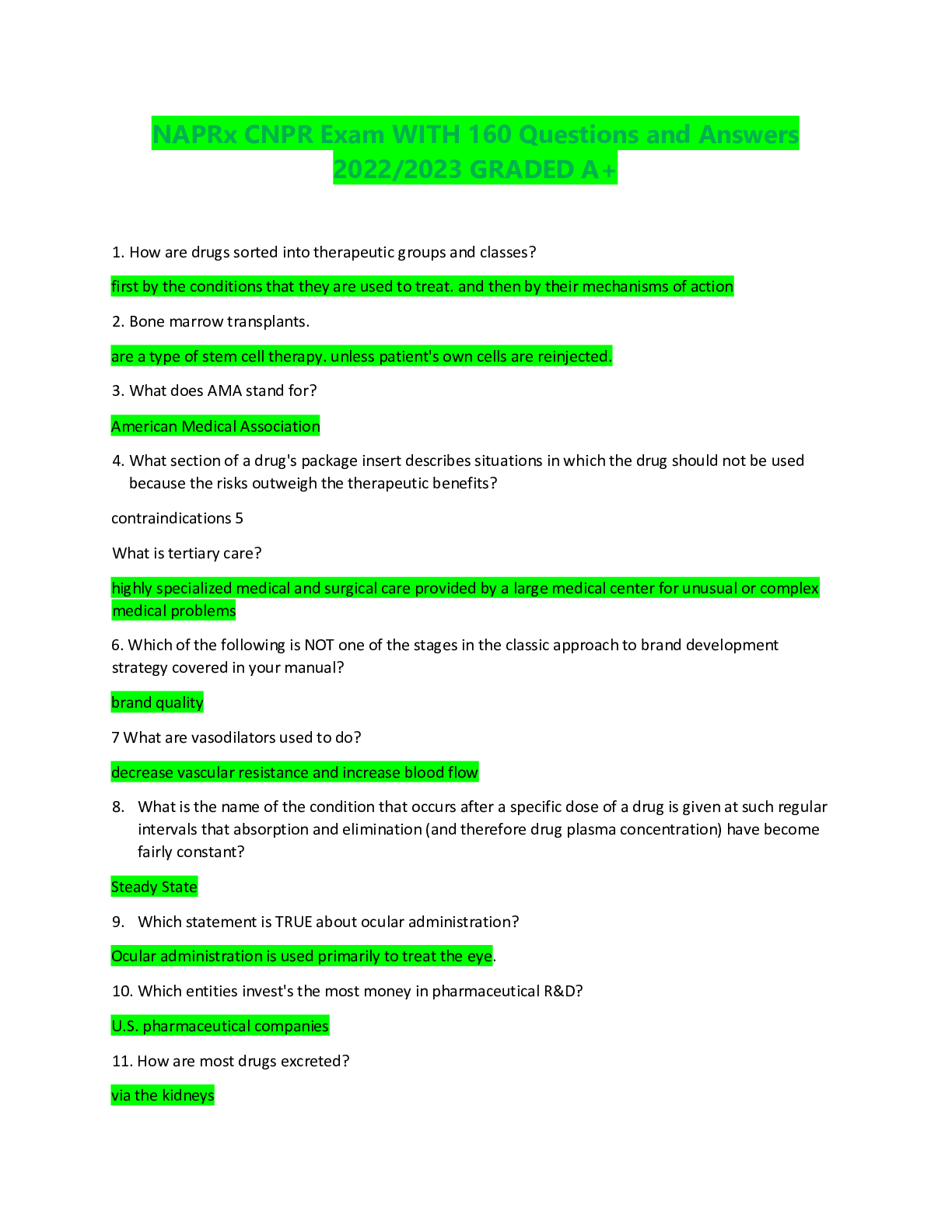
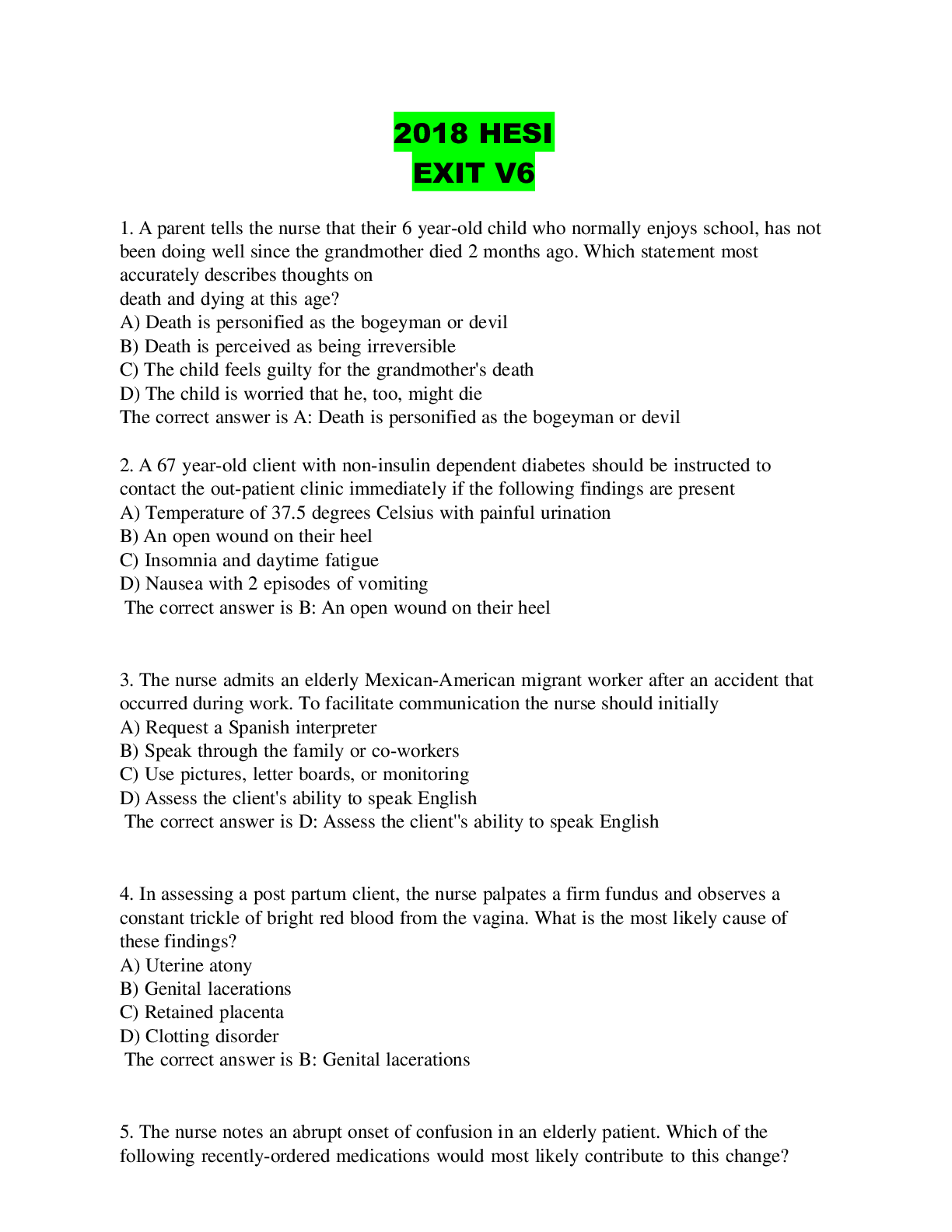
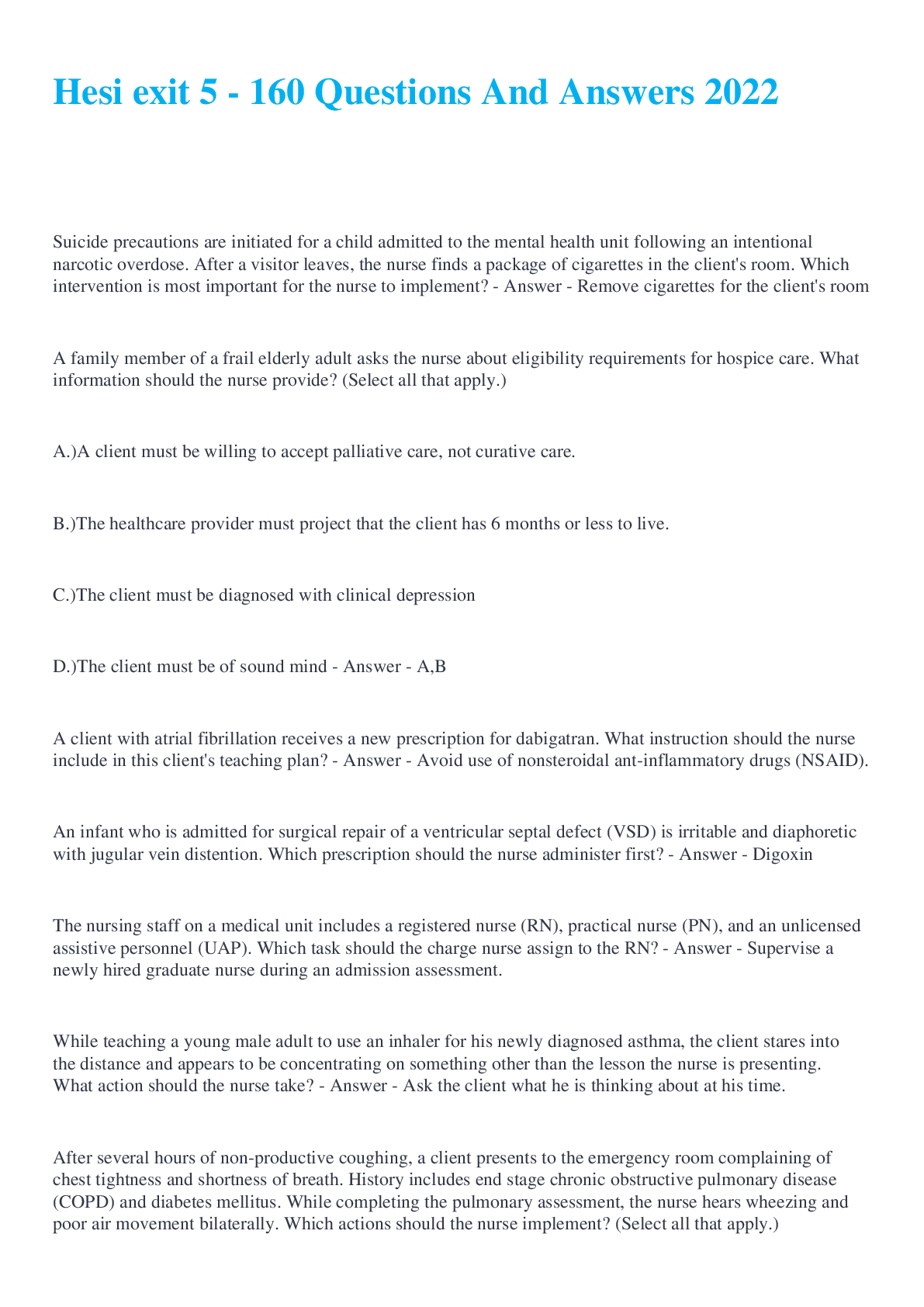
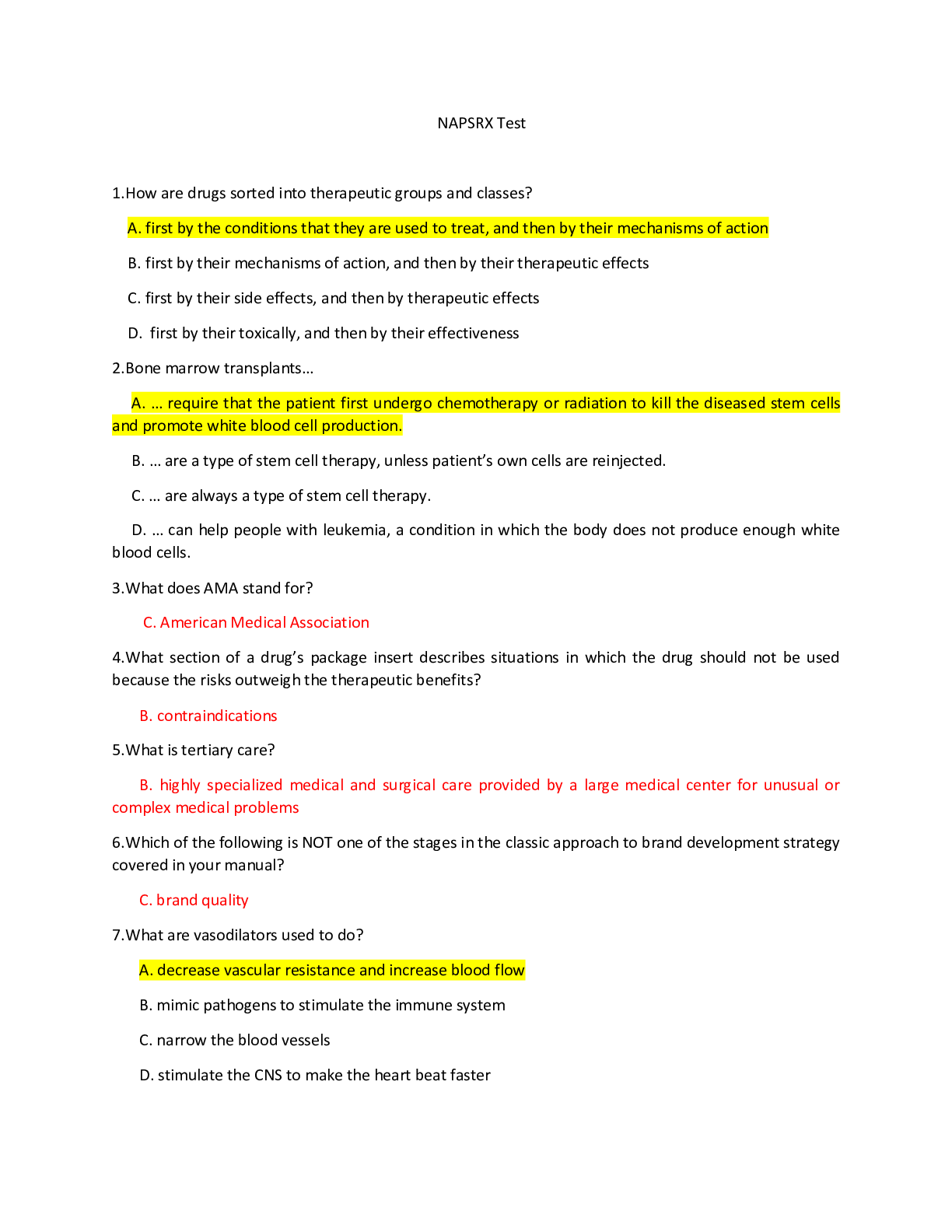
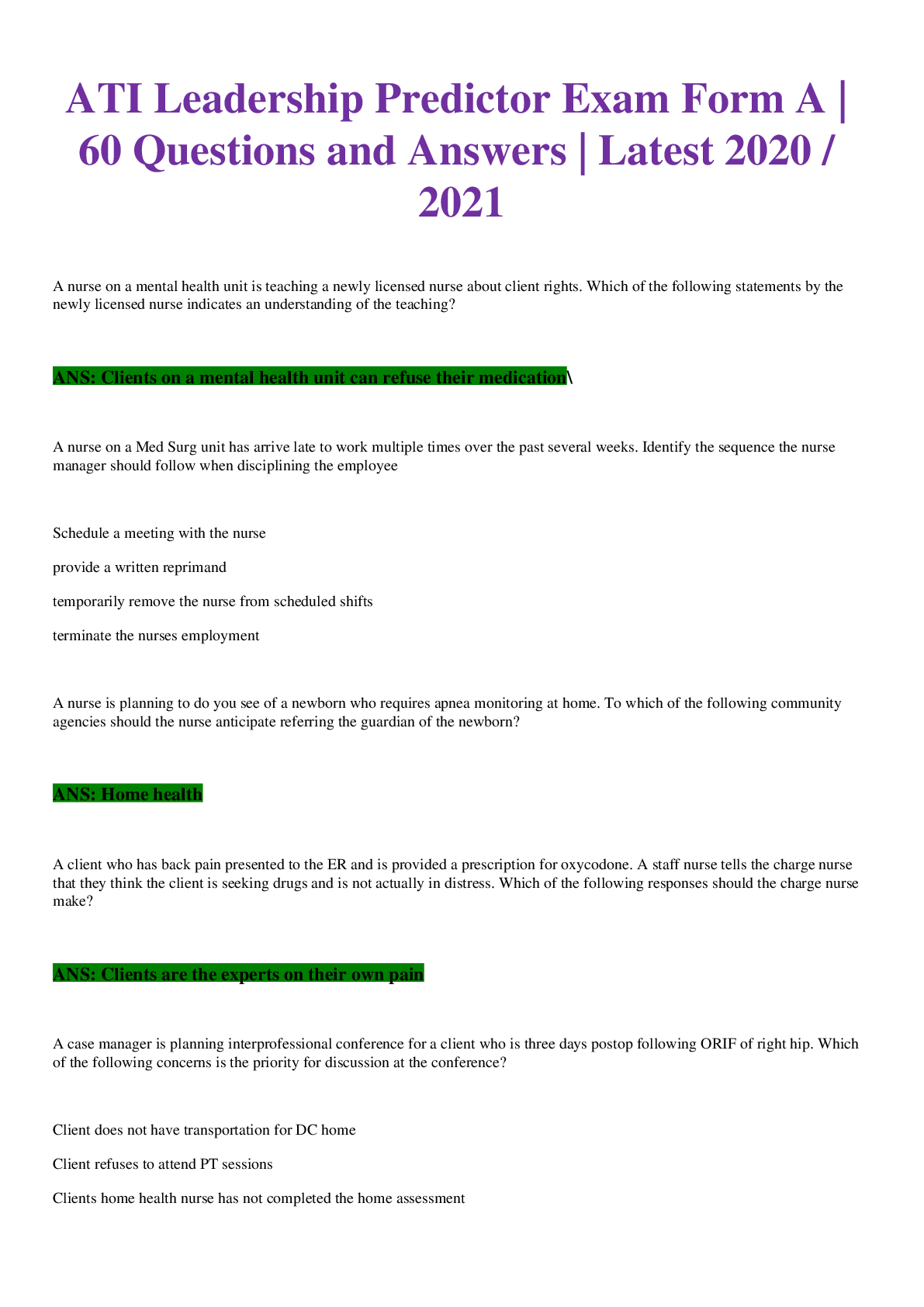
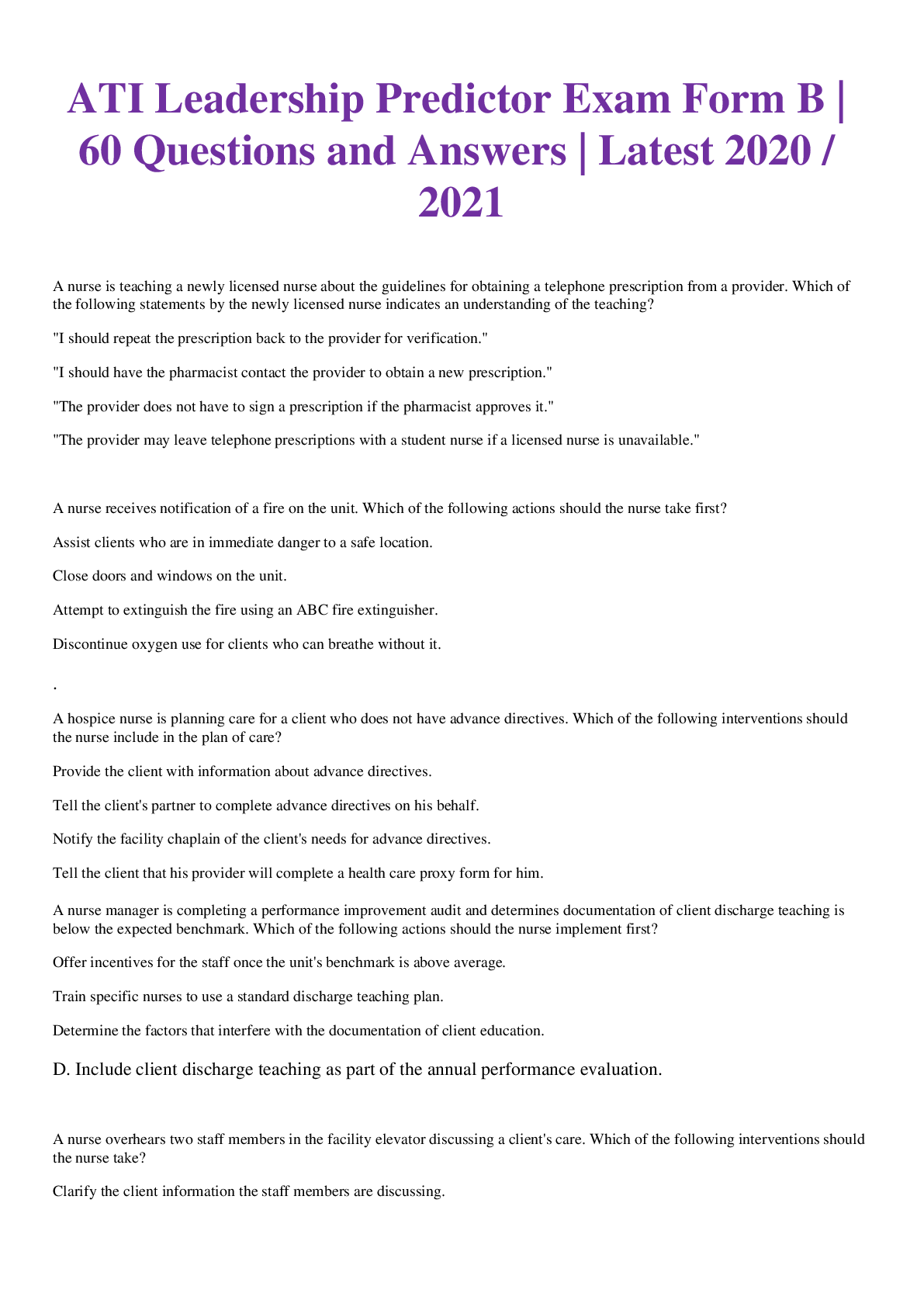
.png)
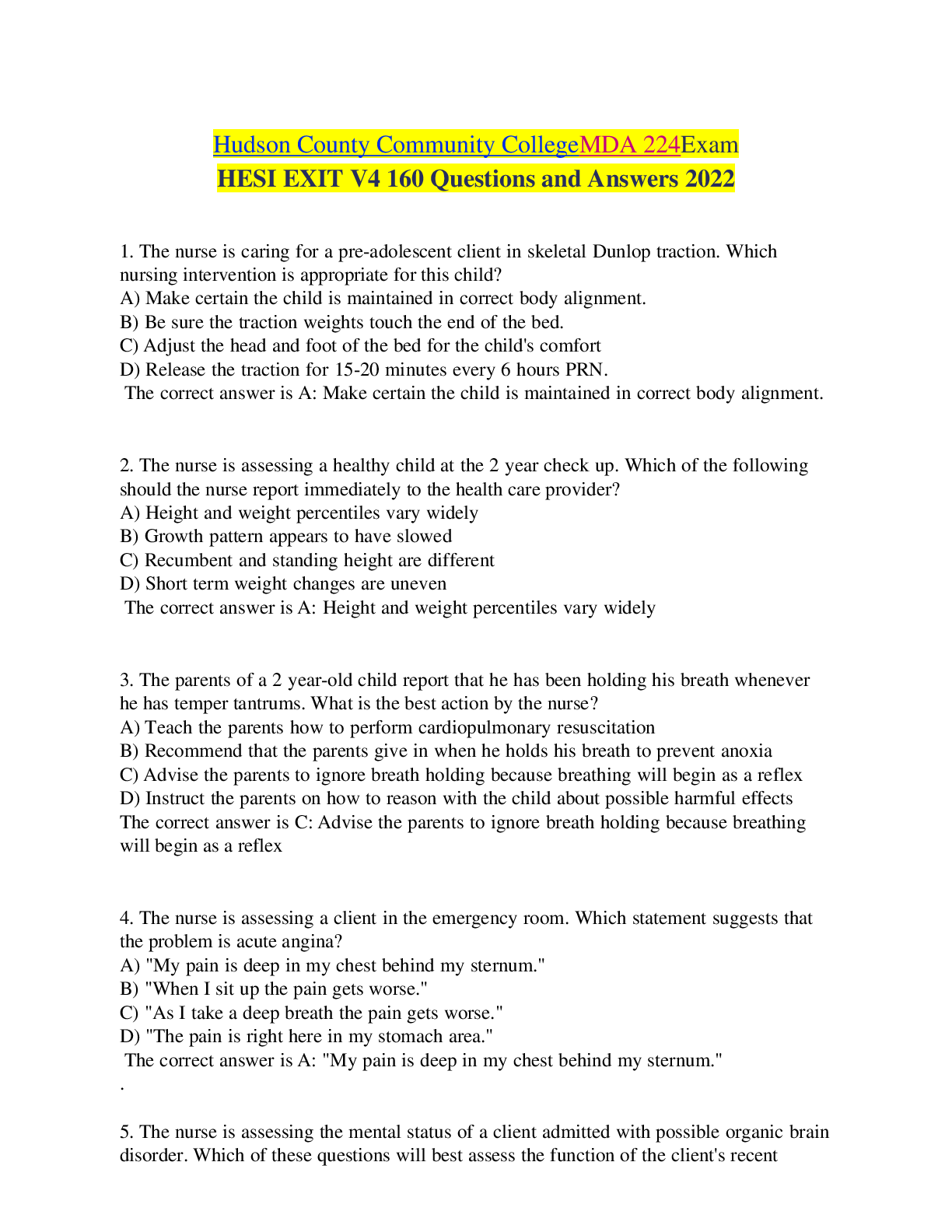
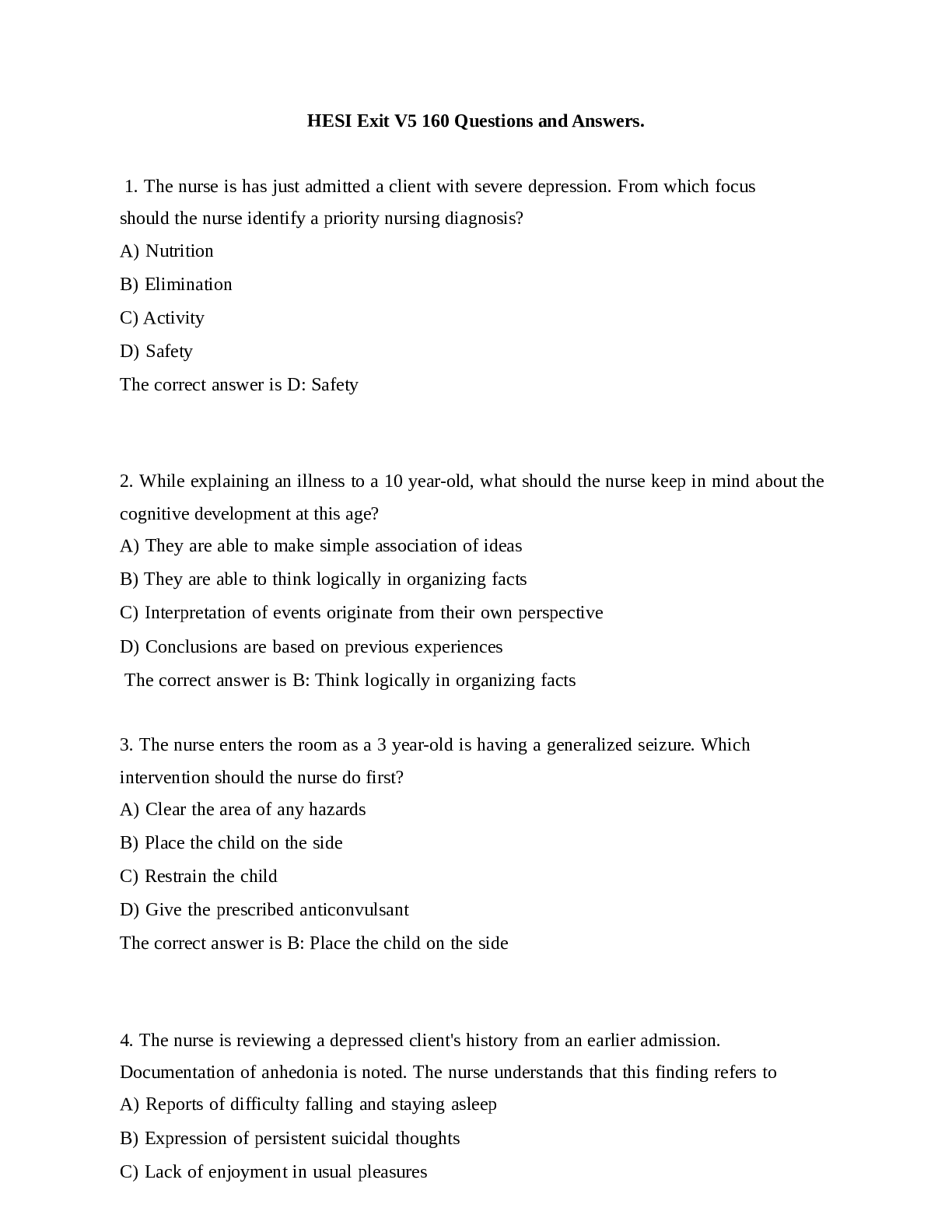
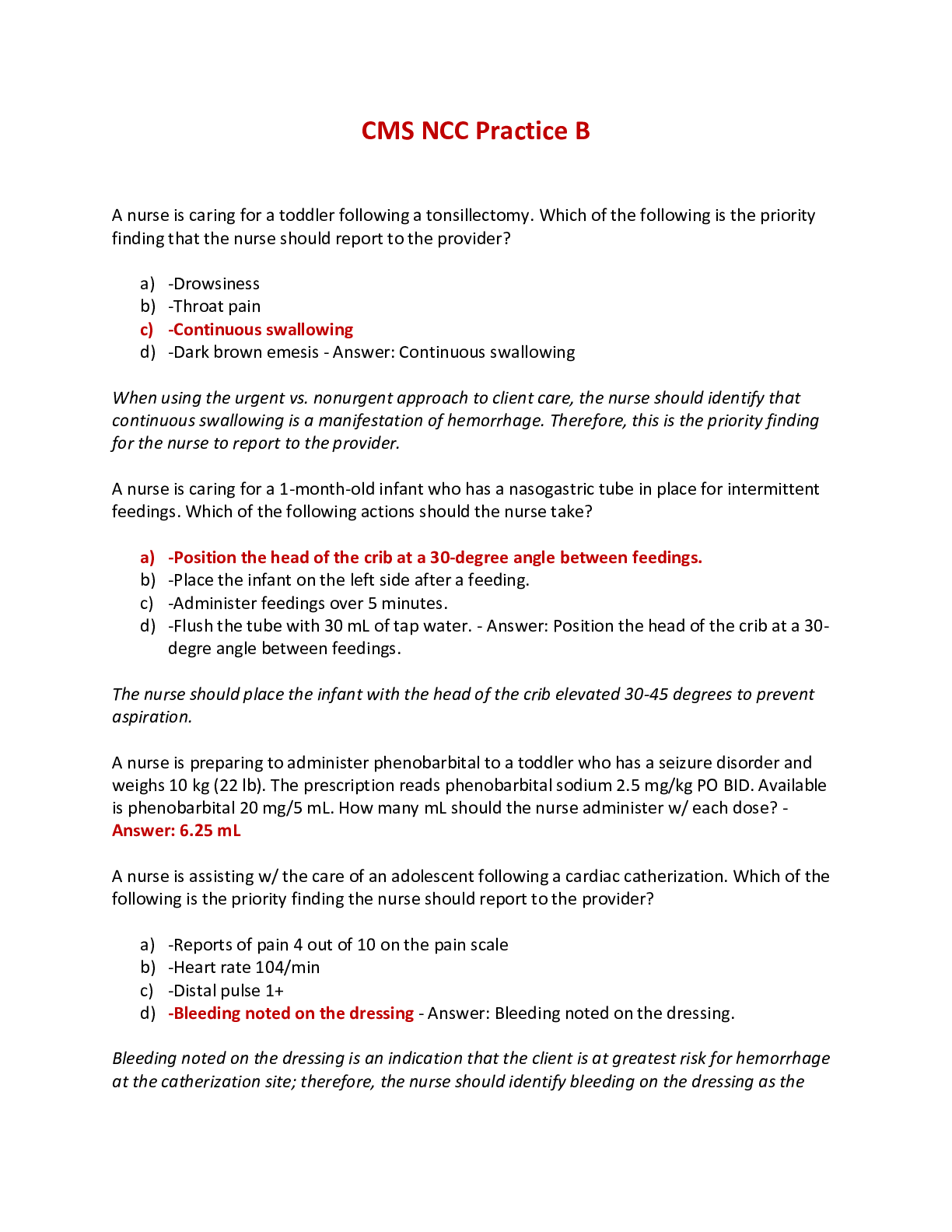
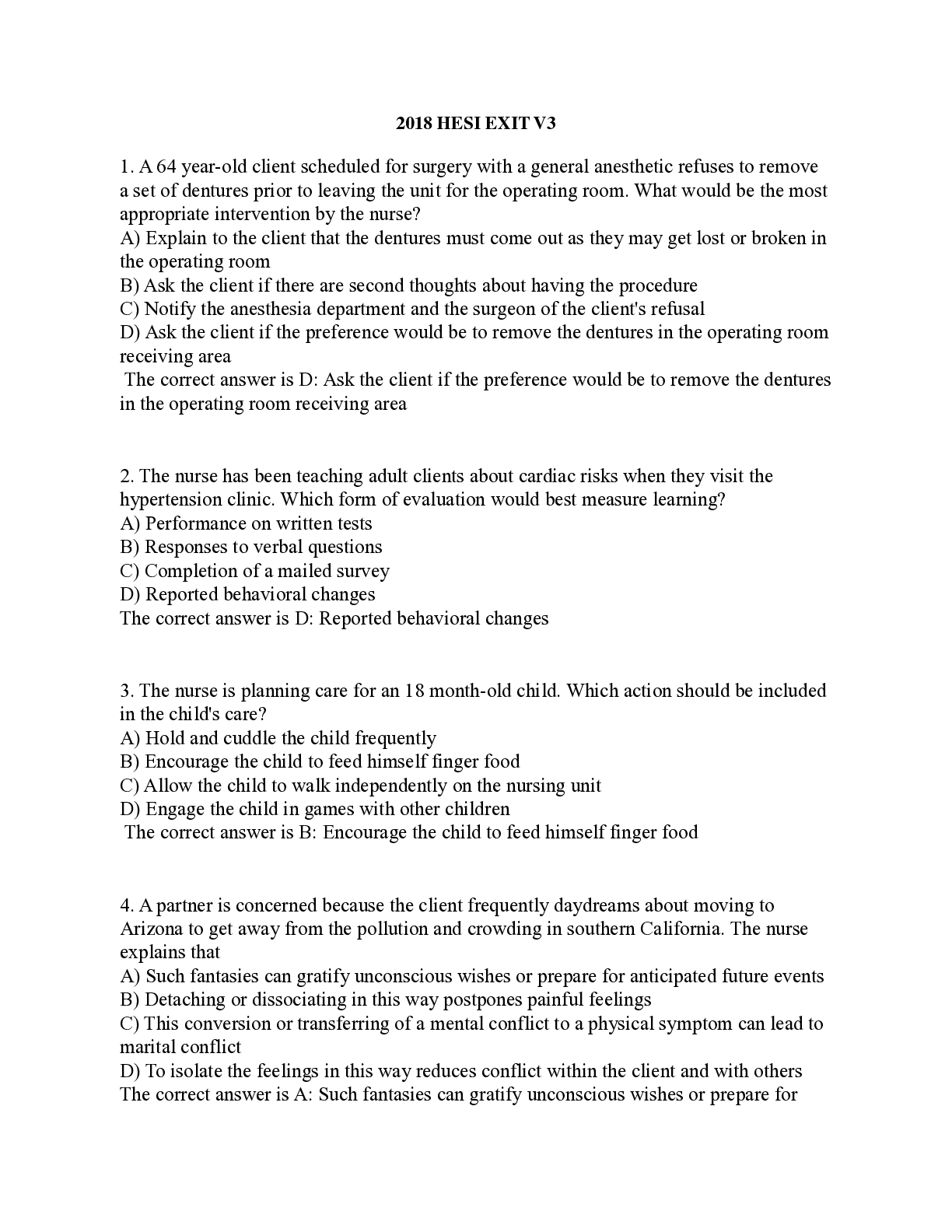
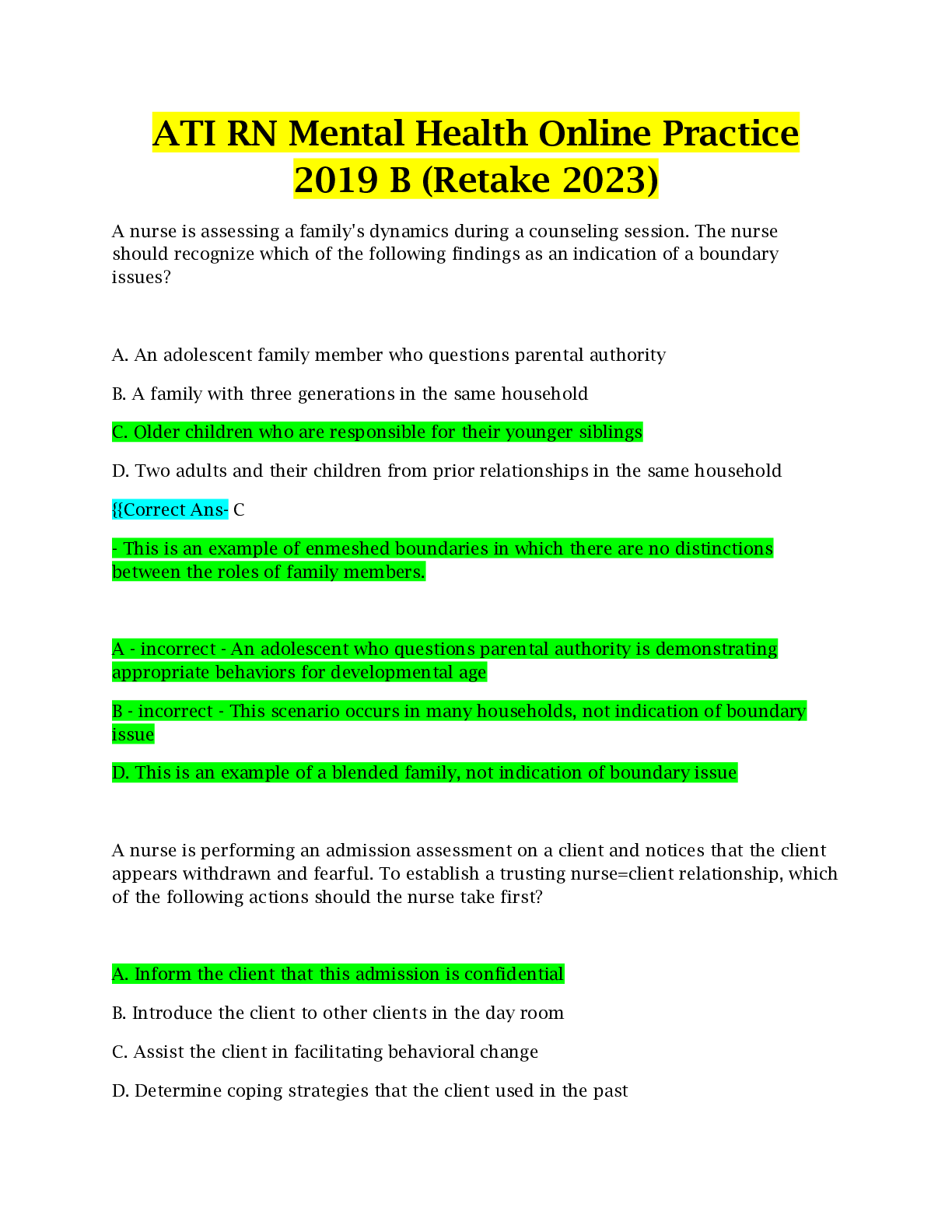

.png)
